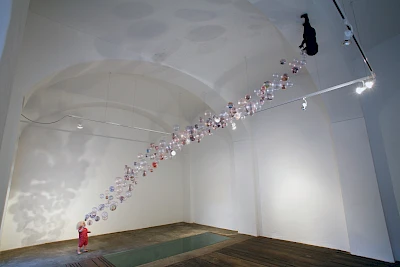Pandora's Box
| Year: | 2011 |
| City: | Vienna, Austria |
| Measures: | site specific installation |
| Media: | Mixed Media |
| Exhibitions: | |
| Catalogues: |
The installation shows the complex interplay between hope, longing and the consequences of their aspirations and draws parallels to the ancient myth of Pandora's box.
According to Hesiod's "Works and Days", Zeus, the father of all the gods, gave Pandora the box with strict instructions never to open it. Despite the warning, Pandora, like Eve in the biblical myth, disobeyed and released all the evils of the world in an instant - except for hope, which remained trapped inside.
The myth is interpreted in different ways: Some see the remaining of hope as salvation, which was thus prevented from spreading terror, while others claim that the non-existence of hope would be the greatest punishment.
Based on the idea that the evils of the world do not depend on external negativity but on unfulfilled hopes trapped in a metaphorical box, this work questions whether the pursuit of desires driven by greed leads to true happiness or instead breeds resentment and avarice when desires go unfulfilled.
In this installation, Boukal explores these themes through the lens of a child reaching for the wish-filled bubbles. The child's shadow, reflected on the ceiling, symbolizes the intersection between the desires from below and the universal dreams from above. This encounter stands for the tension between the desire to fulfill one's wishes and the fear of failure.
The work encourages reflection on current issues in a society driven by a consumerist mentality in which people follow general desires dictated by the media. In this context, the pursuit of unattainable status symbols can lead to "new" problems and failures, reflecting the observations of sociologist Bauman, who describes Western man as a victim of the market - alone, rootless, content with a false prosperity that dissolves with each inevitable new need.














